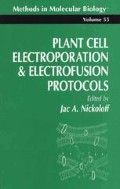Abstract
Protoplast fusion and subsequent in vitro plant regeneration, leading to somatic hybridization, offer opportunities for transferring entire genomes from one plant into another, regardless of the interspecific crossing barriers. In contrast to techniques for plant transformation that are aimed at single-gene transfer, protoplast fusion is needed when polygenic traits are concerned, as is frequently encountered in the genetics of higher plants. Several Solanaceous species, including potato, have been used with greater success than other higher plant species in somatic hybridization because they are more responsive to the protoplast regeneration process. There are two commonly used procedures to induce cell fusion, namely polyethylene glycol (PEG)-induced protoplast fusion and protoplast electrofusion. These procedures have been the subject of several reviews indicating that electrofusion is generally more efficient (1–5). Electrofusion is superior to PEG-induced protoplast fusion in the following aspects:
-
1.
Simplicity of the fusion process;
-
2.
Less toxicity and less physical damage to the protoplasts;
-
3.
Large fusion volume allowing more protoplasts to be treated; and
-
4.
Fine control of the fusion process with the availability of commercial electrofusion equipment.
Access this chapter
Tax calculation will be finalised at checkout
Purchases are for personal use only
References
Negrutiu, I., de Brouwer, D., Watts, J. W., Sidorov, V. I., Dirks, R., and Jacobs, M. (1986) Fusion of plant protoplast: a study using auxotrophic mutants of Nicotiana plumbaginifolia, Viviani. Theor. Appl. Genet. 72, 279–286.
Bates, G. W., Saunders, J. A., and Sowers, A. E. (1987) Electrofusion: principles and applications, in Cell Fusion (Sowers, A. E., ed.), Plenum, New York, pp. 367–395.
Saunders, J. A. and Bates, G. W. (1987) Chemically induced fusion of plant protoplasts, in Cell Fuston (Sowers, A. E., ed), Plenum, New York, pp. 497–520.
Fish, N., Karp, A., and Jones, M. G. K. (1988) Production of somatic hybrids by electrofusion in Solanum. Theor. Appl. Genet. 76, 260–266.
San, H. L., Vedel, F., Sihachakr, D., and Remy, R. (1990) Morphological and molecular characterization of fertile tetraploid somatic hybrids produced by proto-plast, electrofusion and PEG-induced fusion between Lycopersicon esculentum Mill and Lycopersicon peruvianum Mill Mol. Gen Genet 221, 17–26.
Saunders, J. A., Smith, C. R., and Kaper, J. M. (1989) Effects of electroporation pulse wave on the incorporation of viral RNA into tobacco protoplasts. Biotechniques 7(10), 1124–1131.
Masson, J., Lancelm, D., Bellini, C., Lecerf, M., Guerche, P., and Pelletier, G. (1989) Selection of somatic hybrids between diploid clones of potato (Solanum tuberosum L.) transformed by direct gene transfer. Theor. Appl. Genet. 78, 153–l59.
de Vries, S. E., Jacobsen, E., Jones, M. G. K., Loonen, A. E. H. M., Tempelaar, M. J., and Wijbrandi, J. (1987) Somatic hybridization of amino acid analogue-resistant cell lines of potato (Solarium tuberosum L.) by electrofusion. Theor. Appl. Genet. 73, 451–458
Puite, K. J., Roest, S., and Pijnacker, L. P. (1986) Somatic hybrid potato plants after electrofusion of diploid Solanum tuberosum and Solanum phureja Plant Cell Rep. 5, 262–265
Desborough, S. L. (1983) Potato (Solanum tuberosum L), in Isozymes in Plant Genetics and Breeding, Part B (Tanksley, S. D. and Orton, T. J, eds), Elsevier, Amsterdam, pp. 167–188.
Shields, C. R., Orton, T. J., and Stuber, C. W. (1983) An outline of general resource needs and procedures for the electrophoretic separation of active enzymes from plant tissue, in Isozymes in Plant Genetics and Breeding, Part A (Tanksley, S. D. and Orton, T. J., eds), Elsevier, Amsterdam, pp. 443–468.
Landry, B. S. and Michelmore, R. W. (1987) Methods and applications of restriction fragment length polymorphism analysis to plants, in Tailoring Genes for Crop Improvement: An Agricultural Perspective. (Bruening, G., Harada, J., and Hollaender, A., eds.), Plenum, New York, pp. 25–44
Author information
Authors and Affiliations
Editor information
Editors and Affiliations
Rights and permissions
Copyright information
© 1995 Humana Press Inc., Totowa, NJ
About this protocol
Cite this protocol
Cheng, J., Saunders, J.A. (1995). Protoplast Electrofusion and Regeneration in Potato. In: Nickoloff, J.A. (eds) Plant Cell Electroporation and Electrofusion Protocols. Methods in Molecular Biology™, vol 55. Springer, Totowa, NJ. https://doi.org/10.1385/0-89603-328-7:181
Download citation
DOI: https://doi.org/10.1385/0-89603-328-7:181
Publisher Name: Springer, Totowa, NJ
Print ISBN: 978-0-89603-328-3
Online ISBN: 978-1-59259-542-6
eBook Packages: Springer Protocols

